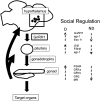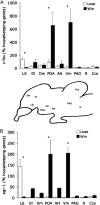Social information changes the brain
- PMID: 23045669
- PMCID: PMC3477382
- DOI: 10.1073/pnas.1202552109
Social information changes the brain
Abstract
Social animals live in complex physical and social environments requiring them to attend and rapidly respond to social and environmental information by changing their behavior. A key social influence is rank or status, a ubiquitous element in animal societies. Rank typically regulates access to reproduction and other resources, among other consequences for individuals. Because reproduction is arguably the most important event in any animals' life, understanding how reproduction is regulated by social status and related physiological factors can instruct our understanding of evolutionary change. This article reviews evidence from a model social system in which reproduction is tightly controlled by social status. Surprisingly, changes in social status have rapid and profound effects over very short time scales and radically alter overt behavior, as well as physiological, cellular, and molecular factors that regulate reproductive capacity.
Conflict of interest statement
The authors declare no conflict of interest.
Figures





Similar articles
-
Mechanistic target of rapamycin (mTOR) implicated in plasticity of the reproductive axis during social status transitions.Gen Comp Endocrinol. 2019 Oct 1;282:113209. doi: 10.1016/j.ygcen.2019.113209. Epub 2019 Jun 18. Gen Comp Endocrinol. 2019. PMID: 31226256 Free PMC article.
-
Social regulation of reproduction in male cichlid fishes.Gen Comp Endocrinol. 2014 Oct 1;207:2-12. doi: 10.1016/j.ygcen.2014.04.038. Epub 2014 May 20. Gen Comp Endocrinol. 2014. PMID: 24859257 Review.
-
Social regulation of gene expression in the hypothalamic-pituitary-gonadal axis.Physiology (Bethesda). 2011 Dec;26(6):412-23. doi: 10.1152/physiol.00032.2011. Physiology (Bethesda). 2011. PMID: 22170959 Review.
-
Social regulation of male reproductive plasticity in an African cichlid fish.Integr Comp Biol. 2013 Dec;53(6):938-50. doi: 10.1093/icb/ict017. Epub 2013 Apr 23. Integr Comp Biol. 2013. PMID: 23613320 Free PMC article. Review.
-
Social regulation of gonadotropin-releasing hormone.J Exp Biol. 2002 Sep;205(Pt 17):2567-81. doi: 10.1242/jeb.205.17.2567. J Exp Biol. 2002. PMID: 12151363
Cited by
-
Social Transitions Cause Rapid Behavioral and Neuroendocrine Changes.Integr Comp Biol. 2015 Aug;55(2):294-306. doi: 10.1093/icb/icv057. Epub 2015 Jun 1. Integr Comp Biol. 2015. PMID: 26037297 Free PMC article. Review.
-
Electrical synapses connect a network of gonadotropin releasing hormone neurons in a cichlid fish.Proc Natl Acad Sci U S A. 2015 Mar 24;112(12):3805-10. doi: 10.1073/pnas.1421851112. Epub 2015 Mar 9. Proc Natl Acad Sci U S A. 2015. PMID: 25775522 Free PMC article.
-
Mechanistic target of rapamycin (mTOR) implicated in plasticity of the reproductive axis during social status transitions.Gen Comp Endocrinol. 2019 Oct 1;282:113209. doi: 10.1016/j.ygcen.2019.113209. Epub 2019 Jun 18. Gen Comp Endocrinol. 2019. PMID: 31226256 Free PMC article.
-
Expression of novel androgen receptors in three GnRH neuron subtypes in the cichlid brain.bioRxiv [Preprint]. 2024 Feb 4:2024.02.02.578641. doi: 10.1101/2024.02.02.578641. bioRxiv. 2024. Update in: J Neuroendocrinol. 2024 Nov;36(11):e13429. doi: 10.1111/jne.13429. PMID: 38352335 Free PMC article. Updated. Preprint.
-
Female cichlids attack and avoid-but will still mate with-androgen receptor mutant males that lack male-typical body coloration.bioRxiv [Preprint]. 2023 Nov 4:2023.11.02.565323. doi: 10.1101/2023.11.02.565323. bioRxiv. 2023. Update in: Horm Behav. 2024 Jul;163:105564. doi: 10.1016/j.yhbeh.2024.105564. PMID: 37961273 Free PMC article. Updated. Preprint.
References
-
- Wilson EO. Sociobiology: The New Synthesis. Cambridge, MA: Harvard Univ Press; 1975.
-
- Drews C. The concept and definition of dominance in animal behaviour. Behaviour. 1993;125:283–313.
-
- Marmot MG, et al. Health inequalities among British civil servants: The Whitehall II study. Lancet. 1991;337:1387–1393. - PubMed
Publication types
MeSH terms
Substances
Grants and funding
LinkOut - more resources
Full Text Sources

